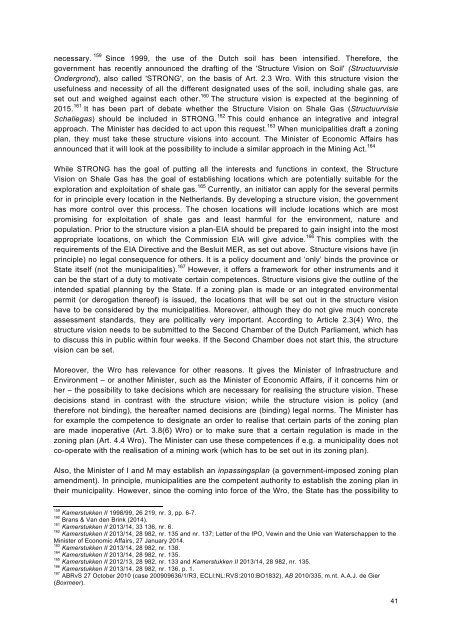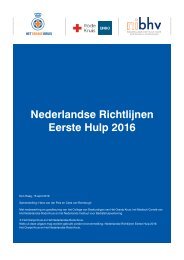Thesis-Anne-Vos-Masters-SBR-and-EU-Law-3
Thesis-Anne-Vos-Masters-SBR-and-EU-Law-3
Thesis-Anne-Vos-Masters-SBR-and-EU-Law-3
Create successful ePaper yourself
Turn your PDF publications into a flip-book with our unique Google optimized e-Paper software.
necessary. 159 Since 1999, the use of the Dutch soil has been intensified. Therefore, the<br />
government has recently announced the drafting of the 'Structure Vision on Soil' (Structuurvisie<br />
Ondergrond), also called 'STRONG', on the basis of Art. 2.3 Wro. With this structure vision the<br />
usefulness <strong>and</strong> necessity of all the different designated uses of the soil, including shale gas, are<br />
set out <strong>and</strong> weighed against each other. 160 The structure vision is expected at the beginning of<br />
2015. 161 It has been part of debate whether the Structure Vision on Shale Gas (Structuurvisie<br />
Schaliegas) should be included in STRONG. 162 This could enhance an integrative <strong>and</strong> integral<br />
approach. The Minister has decided to act upon this request. 163 When municipalities draft a zoning<br />
plan, they must take these structure visions into account. The Minister of Economic Affairs has<br />
announced that it will look at the possibility to include a similar approach in the Mining Act. 164<br />
While STRONG has the goal of putting all the interests <strong>and</strong> functions in context, the Structure<br />
Vision on Shale Gas has the goal of establishing locations which are potentially suitable for the<br />
exploration <strong>and</strong> exploitation of shale gas. 165 Currently, an initiator can apply for the several permits<br />
for in principle every location in the Netherl<strong>and</strong>s. By developing a structure vision, the government<br />
has more control over this process. The chosen locations will include locations which are most<br />
promising for exploitation of shale gas <strong>and</strong> least harmful for the environment, nature <strong>and</strong><br />
population. Prior to the structure vision a plan-EIA should be prepared to gain insight into the most<br />
appropriate locations, on which the Commission EIA will give advice. 166 This complies with the<br />
requirements of the EIA Directive <strong>and</strong> the Besluit MER, as set out above. Structure visions have (in<br />
principle) no legal consequence for others. It is a policy document <strong>and</strong> ‘only’ binds the province or<br />
State itself (not the municipalities). 167 However, it offers a framework for other instruments <strong>and</strong> it<br />
can be the start of a duty to motivate certain competences. Structure visions give the outline of the<br />
intended spatial planning by the State. If a zoning plan is made or an integrated environmental<br />
permit (or derogation thereof) is issued, the locations that will be set out in the structure vision<br />
have to be considered by the municipalities. Moreover, although they do not give much concrete<br />
assessment st<strong>and</strong>ards, they are politically very important. According to Article 2.3(4) Wro, the<br />
structure vision needs to be submitted to the Second Chamber of the Dutch Parliament, which has<br />
to discuss this in public within four weeks. If the Second Chamber does not start this, the structure<br />
vision can be set.<br />
Moreover, the Wro has relevance for other reasons. It gives the Minister of Infrastructure <strong>and</strong><br />
Environment – or another Minister, such as the Minister of Economic Affairs, if it concerns him or<br />
her – the possibility to take decisions which are necessary for realising the structure vision. These<br />
decisions st<strong>and</strong> in contrast with the structure vision; while the structure vision is policy (<strong>and</strong><br />
therefore not binding), the hereafter named decisions are (binding) legal norms. The Minister has<br />
for example the competence to designate an order to realise that certain parts of the zoning plan<br />
are made inoperative (Art. 3.8(6) Wro) or to make sure that a certain regulation is made in the<br />
zoning plan (Art. 4.4 Wro). The Minister can use these competences if e.g. a municipality does not<br />
co-operate with the realisation of a mining work (which has to be set out in its zoning plan).<br />
Also, the Minister of I <strong>and</strong> M may establish an inpassingsplan (a government-imposed zoning plan<br />
amendment). In principle, municipalities are the competent authority to establish the zoning plan in<br />
their municipality. However, since the coming into force of the Wro, the State has the possibility to<br />
159<br />
Kamerstukken II 1998/99, 26 219, nr. 3, pp. 6-7.<br />
160<br />
Brans & Van den Brink (2014).<br />
161<br />
Kamerstukken II 2013/14, 33 136, nr. 6.<br />
162<br />
Kamerstukken II 2013/14, 28 982, nr. 135 <strong>and</strong> nr. 137; Letter of the IPO, Vewin <strong>and</strong> the Unie van Waterschappen to the<br />
Minister of Economic Affairs, 27 January 2014.<br />
163<br />
Kamerstukken II 2013/14, 28 982, nr. 138.<br />
164<br />
Kamerstukken II 2013/14, 28 982, nr. 135.<br />
165<br />
Kamerstukken II 2012/13, 28 982, nr. 133 <strong>and</strong> Kamerstukken II 2013/14, 28 982, nr. 135.<br />
166<br />
Kamerstukken II 2013/14, 28 982, nr. 136, p. 1.<br />
167<br />
ABRvS 27 October 2010 (case 200909636/1/R3, ECLI:NL:RVS:2010:BO1832), AB 2010/335, m.nt. A.A.J. de Gier<br />
(Boxmeer).<br />
41



